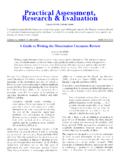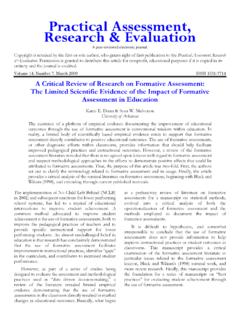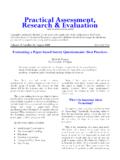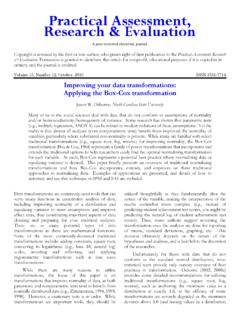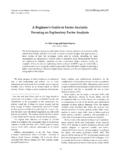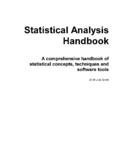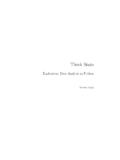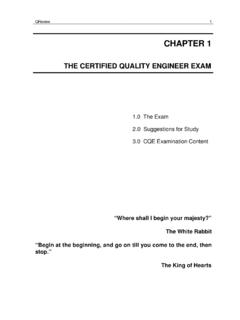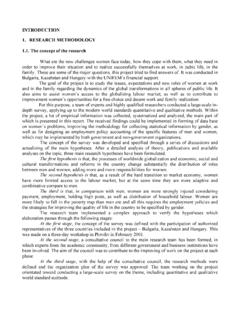Transcription of Mixing Interview and Questionnaire Methods: …
1 A peer-reviewed electronic journal. Copyright is retained by the first or sole author, who grants right of first publication to the practical Assessment, Research & Evaluation. Permission is granted to distribute this article for nonprofit, educational purposes if it is copied in its entirety and the journal is 15, Number 1, January 2010 ISSN 1531-7714 Mixing Interview and Questionnaire methods : practical problems in aligning data Lois R. Harris, The University of Auckland Gavin T. L. Brown, The Hong Kong Institute of Education Structured questionnaires and semi-structured interviews are often used in mixed method studies to generate confirmatory results despite differences in methods of data collection, analysis , and interpretation. A review of 19 Questionnaire - Interview comparison studies found that consensus and consistency statistics were generally weak between methods .
2 Problems in aligning data from the two different methods are illustrated in a Questionnaire - Interview study of teacher conceptions of assessment. Poor alignment appeared attributable to: differences in data collection procedures, the complexity and instability of the construct being investigated, difficulties in making data comparable, lack of variability in participant responses, greater sensitivity to context and seemingly emotive responses within the Interview , possible misinterpretation of some Questionnaire prompts, and greater control of content exposure in the Questionnaire . Results indicated that if confirmatory results are being sought, researchers must create tightly aligned and structured instruments; present the construct in a simple, concrete, and highly contextualised manner; collect the two types of data with a minimal time gap; and estimate agreement between methods using consistency statistics.
3 However, the cost of confirmation through strong alignment may lead to the loss of rich complementary data obtained through allowing each method to be analysed in its own right. Introduction Questionnaires and interviews are often used together in mixed method studies investigating educational assessment ( , Brookhart & Durkin, 2003; Lai & Waltman, 2008). While questionnaires can provide evidence of patterns amongst large populations, qualitative Interview data often gather more in-depth insights on participant attitudes, thoughts, and actions (Kendall, 2008). This article focuses on comparing structured questionnaires with semi-structured interviews, although other types of questionnaires and interviews are examined in the literature review.
4 In a structured Questionnaire , participants respond to prompts by selecting from predetermined answers ( , Likert scales, multiple choice responses); these data are typically analysed quantitatively. In a semi-structured Interview , interviewers begin with a small set of open-ended questions, but spend considerable time probing participant responses, encouraging them to provide detail and clarification; these data are generally analysed qualitatively. A REVIEW OF LITERATURE Methodological differences between questionnaires and interviews Although Questionnaire and Interview data are frequently reported together, studies within educational contexts seldom examine the level of similarity between people s Questionnaire and Interview responses to determine when and if comparisons between these data sets are appropriate.
5 Mixed methods researchers deny that the paradigmatic differences between ways of viewing the world make qualitative and quantitative methods incompatible ( , Day, Sammons, & Gu, 2008; Ryan & Bernard, 2000; Smith, 2006). However, practical Assessment, Research & Evaluation, Vol 15, No 1 Page 2 Harris & Brown, Mixing Interview & Questionnaire methods the protocols for data collection and analysis developed for questionnaires and interviews may have evolved from differing ways of viewing the world making it possible that method effects exist. In the research methods literature, questionnaires and interviews are seen as having differing and possibly complementary strengths and weaknesses. While questionnaires are usually viewed as a more objective research tool that can produce generalisable results because of large sample sizes, results can be threatened by many factors including: faulty Questionnaire design; sampling and non-response errors; biased Questionnaire design and wording; respondent unreliability, ignorance, misunderstanding, reticence, or bias; errors in coding, processing, and statistical analysis ; and faulty interpretation of results (Oppenheim, 1992).
6 Additionally, Questionnaire research can be seen as over-reliant on instruments and, thus, disconnected from everyday life, with measurement processes creating a spurious or artificial sense of accuracy (Bryman, 2008). Neither are interviews neutral tools; here data are based on personal interactions which lead to negotiated and contextually based results (Fontana & Frey 2000; Silverman, 2000, 2006). While interviews provide contexts where participants can ask for clarification, elaborate on ideas, and explain perspectives in their own words, the interviewer can use questioning to lead or manipulate interviewee responses. Due to the interpersonal nature of the Interview context, participants may be more likely to respond in ways they deem socially desirable (Richman, Keisler, Weisband, & Drasgow, 1999; Yin, 2009).
7 Hence, Interview data are always contrived and, at best, partial and incomplete understandings of a participant s point of view (Lankshear & Knobel, 2004). Additionally, since most qualitative studies have relatively small sample sizes, the results can be difficult to replicate or generalise (Bryman, 2008). Further differences between the two methods can occur through the coding and analysis of the data. For example, while quantitative data are numeric and, hence, more objective, considerable researcher interpretation comes into decisions about excluding specific participants and/or items from the data set, the statistical processes employed to generate results, and the interpretation of results (Oppenheim, 1992). With qualitative data, researchers generally utilise a process of inductive coding, which can be easily influenced by researcher subjectivities (Bryman, 2008).
8 It can also be difficult to judge how well proposed qualitative categorisations actually suit the data as normally only small excerpts are presented for scrutiny in manuscripts. Issues relating to self-reporting also plague both methods . Studies have found that people can simultaneously hold conflicting conceptions and beliefs (Marton & Pong, 2005; Pajares, 1992) which may cause them to respond in seemingly contradictory or inconsistent ways. Additionally, poor or incomplete memory of events, external influences, and lack of time to fully recall information may lead to purposefully or accidentally inaccurate recall and responding (Brewer, Hallman, Fielder, & Kipen, 2004). Also, some people may respond based on what they believe is socially desirable rather than what they think is true; research disagrees about which research modes are most influenced in this way (Richman et al.)
9 , 1999). Oei and Zwart (1986) suggested that participants actually respond differently to Questionnaire and Interview prompts, claiming that face-to-face interviews trigger strong affective responses while questionnaires permit a wide range of responses, of, perhaps, a more cognitively dispassionate nature. However, despite the weaknesses of both questionnaires and interviews, these are important means of obtaining direct responses from participants about their understandings, conceptions, beliefs, and attitudes; hence, these methods cannot and should not be discarded. Studies comparing Questionnaire and Interview results When examining studies comparing these two methods , there are many ways to measure their level of similarity. Consensus of scores is deemed to be present if the exact agreement between methods is 70% or better (Stemler, 2004).
10 However, when scales involve few rating points ( , three or less), then it is highly probable that this agreement will be due to chance. Many studies use Cohen s (1960) kappa statistic ( ) to indicate the degree to which observed rates of agreement are attributable to chance processes. Negative kappa values indicate that the observed levels of agreement are less than would occur purely by chance, zero kappa means consensus rates are equal to chance, values up to .40 are deemed slightly better than chance, values of .41 to .60 are moderately better than chance, while kappa values greater than .60 are stronger than chance. Some studies also use consistency statistics ( , Pearson s r or Cronbach s alpha) to indicate the degree to which, regardless of the actual value awarded, the two methods give higher or lower scores to each participant.

